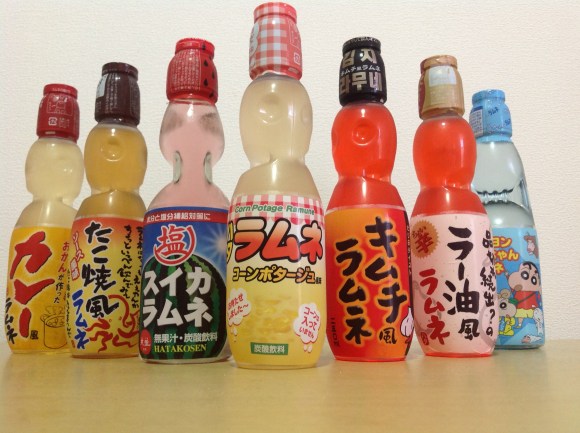 Ramune was one of the first carbonated beverages in Japan and can still be found today in various supermarkets or at festivals and public baths around the country. Over a century after its first appearance, Japanese customers have tended to go for the big name colas, which has in turn caused Ramune producers, such as Osaka’s Hata, to come up with some novel flavors in an effort to stir up interest.
Ramune was one of the first carbonated beverages in Japan and can still be found today in various supermarkets or at festivals and public baths around the country. Over a century after its first appearance, Japanese customers have tended to go for the big name colas, which has in turn caused Ramune producers, such as Osaka’s Hata, to come up with some novel flavors in an effort to stir up interest.
Most recently, a corn flavored Ramune was developed and has celebrated 100,000 bottles sold since its release in March. In honor of this, I picked up some of Hata’s more unique flavors for a whirlwind review of these often overlooked Japanese sodas.
First a little background on Ramune
Alexander Sim was a Scottish pharmacist who moved to Japan in the latter part of the 19th century. As was the trend with pharmacists of that time, he developed a carbonated beverage called mabu soda (marble soda). It was a hit due to its sweet taste…and because people thought it prevented cholera.
The name was a reference to the Codd Neck bottles which held the drink. Codd Neck bottles were the premier choice for carbonated drinks at the time. The gas pressure inside the bottle would hold a marble against the opening thus sealing it. For more on Codd Neck bottles see the end of this report.
The name Ramune came from the English “lemonade”, which describes Mabu Soda’s lemony taste, not unlike 7-Up or Sprite. The bottles fell out of use for other beverages around the world but are still used for Ramune to this day.
Salted Watermelon Ramune
I figured I would start with the tamest of the specialty flavors, Salty Watermelon. Although I was shocked to learn that people put salt on watermelon after last year’s Salty Watermelon Pepsi, I still imagined it to taste like straight watermelon.
On opening the bottle it released a strong yet very pleasant aroma of watermelon. Although it certainly smelled like straight up watermelon, I was surprised by the taste. The flavor of the salted watermelon was a lot smoother and far more delicious than watermelon alone. The salt taste was there but in a behind the scenes kind of way, working only to enhance the watermelon experience. An excellent start to this Ramune journey!
Corn Potage Ramune
This latest special flavor comes following the success of corn potage (corn soup) GariGariKun ice pops from last year. Hata figured if it could work for popsicles, why not pop?
After opening the bottle I could get a very subtle hint of corn. Actually there seemed to be a buttery scent to it as well. As a big fan of corn and butter, this was very promising. However, after drinking it, I felt something was a little off. The smell gave me the sense of something warm and creamy, but of course being a soda it was very thin, bubbly and cold. The corn taste was pretty authentic but kind of clashed with the texture.
I would describe the Corn Potage Ramune as cool and interesting, but not especially delicious on par with other pops. That being said, it’s definitely worth trying at least once just for the weird experience of it all.
Takoyaki Ramune
Takoyaki is a piece of octopus fried inside a ball of batter along with other ingredients and covered in sauce, mayonaise, and flakes of dried fish. It’s a delicious snack that can often be found in roadside food stands, particularly in Osaka, which boasts “the best takoyaki in Japan.” Still it’s hard to imagine how they got this particular flavor into a drink.
When I opened this bottle, it foamed over a little so I used my mouth to catch it quickly before smelling. I immediately received a shock; it tasted just like takoyaki sauce! Takoyaki sauce is somewhat similar to BBQ sauce in other countries. After drinking some more, I began to really get into this flavor. The taste of the sauce gave the drink a zesty tinge that fit perfectly with the sweetness and yet was completely original for a soda flavor. It might have just been my imagination, but I could have sworn it had an aftertaste of octopus.
Rayu Ramune
Rayu is a thin sesame oil-based sauce with chili peppers and sometimes other seasonings like garlic mixed in. Naturally in these hot summer days, chili sauce is the perfect remedy.
At first this drink had a savory smell but didn’t seem very spicy. Still, I winced as I went for the first sip. Surprisingly, it didn’t taste very spicy. It did taste like peppers and had a hearty flavor to it, but was rather mild. A few seconds later though, a spicy aftertaste came out from the back of my throat. Also, I coughed exactly like I do when I eat real spicy foods.
I can only assume the carbonation may have “protected” my tongue from taking in the spiciness. Even after swishing the drink around in my mouth, the spiciness never hit until I swallowed it. This was a really interesting drink and not bad, but probably not one I’d go for again.
Curry Ramune
After the chili sauce soda, I wasn’t expecting a hugely spicy experience with Curry Ramune. Also, Japanese curry tends to be on the milder side. However, the label read “Osaka mom’s homemade curry” which sounded promising.
This soda had the mildest smell of the bunch. After sniffing hard at it, I could get a faint mixture of sweet and savory. The taste was also pretty subdued. In fact, it was more like the regular lemon-lime flavor of Ramune with just a hint of curry and a similar spicy after taste to the Rayu Ramune.
The taste is fine, but really too similar to original Ramune. If you don’t want to get too adventurous with your soda flavors, this one would be the best choice.
Kimchi Ramune
Having easily gone through the Rayu and Curry flavored Ramune, I wasn’t expecting much from the one modeled after Korea’s (and my) favorite spicy pickled vegetables. However, taking an initial whiff made my head snap back. This was the real deal and smelled identical to kimchi!
The taste too mimicked kimchi eerily closely. The savoriness of the vegetables with that zing from fermenting were both amazingly captured in this drink! And sure enough, that same spicy kick came in the back of my throat, but this time was accompanied by a veggie aftertaste. Even more surprising than the similarity with real kimchi was how well this taste worked in soda form. It’s damn good!
Overall, I’d give first place to Kimchi Ramune, with Takoyaki Ramune in a close second and Salted Watermelon taking up third place. They all had their own unique charm though, so if you’re looking for a different way to cool down in Japan this summer, try out one of these reinvented versions of a century-old Japanese beverage.
Hata Co.: Website
All Photos: RocketNews24
How to open a bottle of Ramune
Codd neck bottles can be tricky to open. Here’s a quick guide on how to do it.
After peeling off the plastic wrapper on top of the bottle, a little plastic piece will probably fall off. You might think this was a poorly made cap, but actually it’s the opener.
Inside the neck you’ll see a glass or plastic marble pressed up against the mouth.
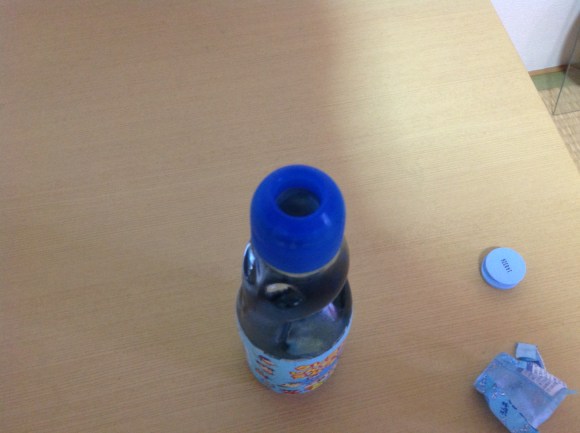
First take off the ring around the opener and put it over the marble.
This is very important: you must smack the opener swift and firmly. Doing it too slowly may cause soda to fire out in all direction resulting in… this.
Then enjoy your drink!
Ramune can be tricky to find. I bought all these at a souvenir shop: Ichi Biri Ryu located near the Dotombori Bridge.


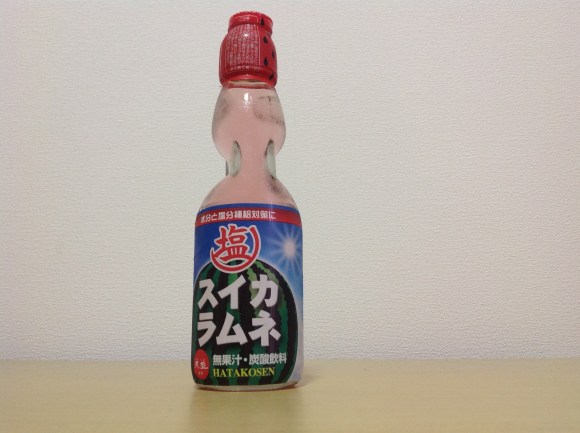
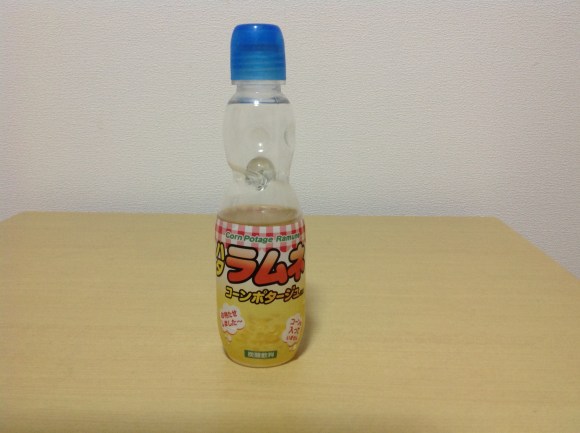
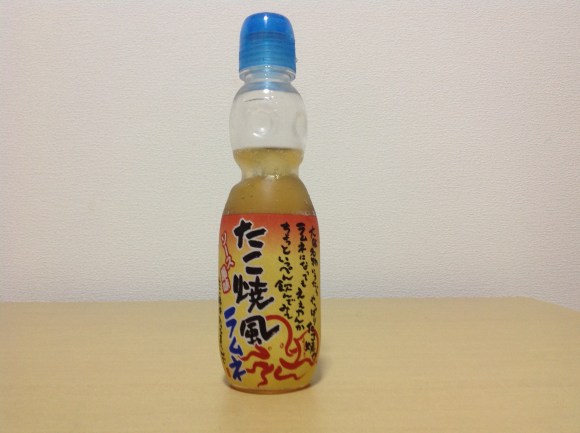
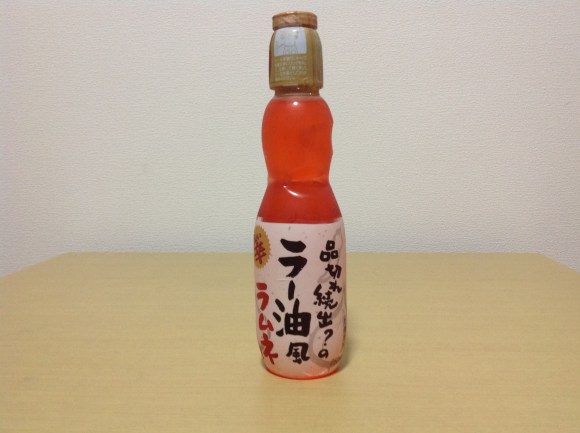
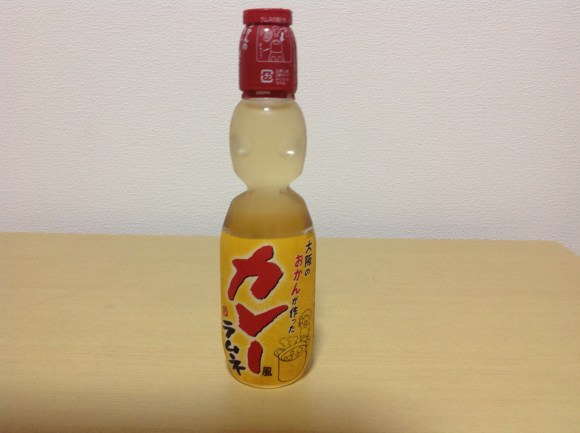
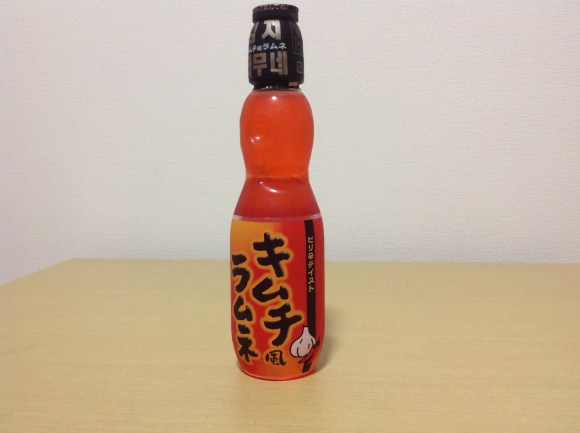
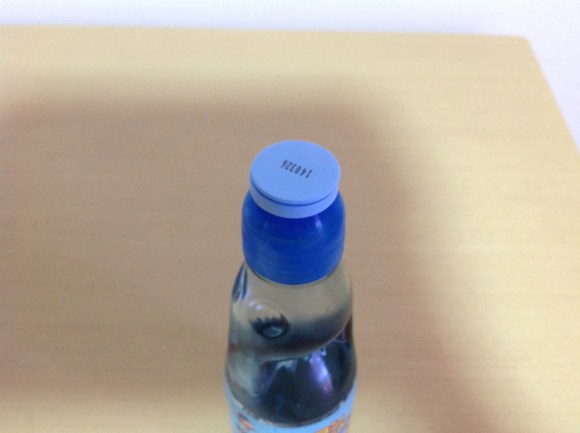
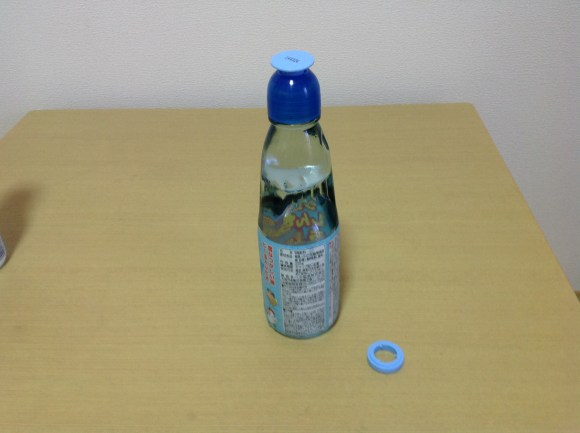
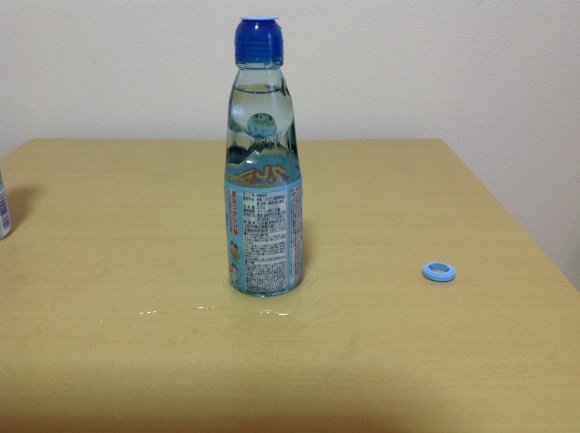
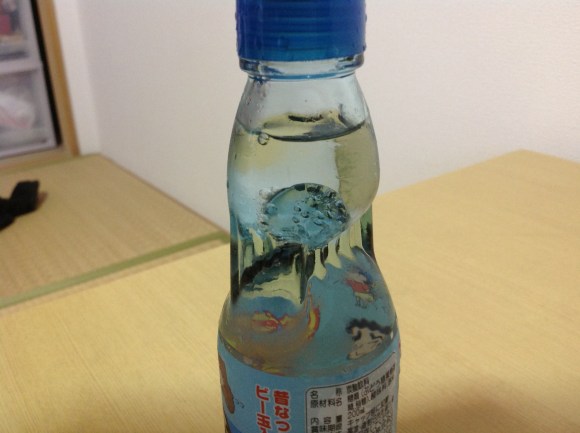
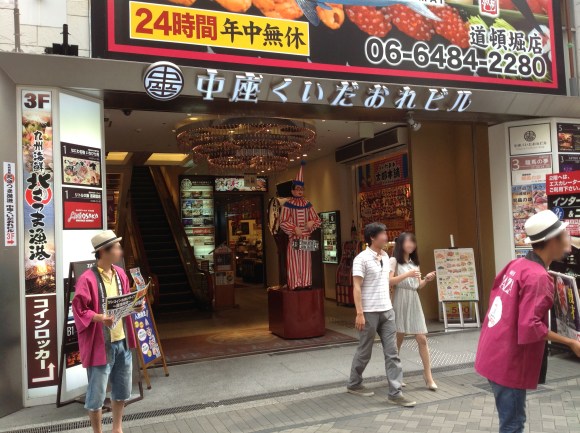
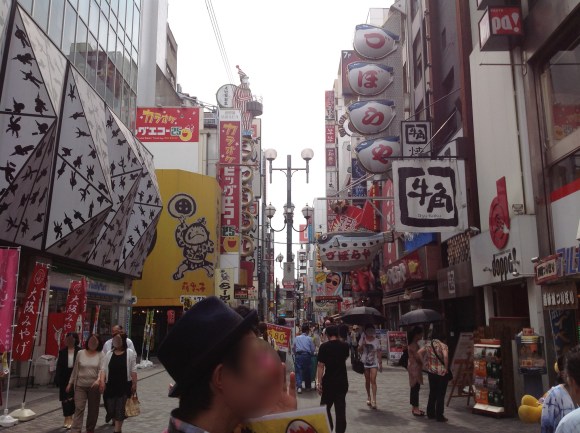
 McDonald’s captures the sweet flavour of Japan with new Ramune milkshake
McDonald’s captures the sweet flavour of Japan with new Ramune milkshake Is ramune another COVID-19 casualty? Iconic Japanese soda faces plummeting sales and bleak summer
Is ramune another COVID-19 casualty? Iconic Japanese soda faces plummeting sales and bleak summer U.S. Rapper Lil Baby makes waves in Japan, but for something other than his music
U.S. Rapper Lil Baby makes waves in Japan, but for something other than his music Japanese sweets lovers soon to be in their blue heaven with beautiful aqua-color Ramune dorayaki
Japanese sweets lovers soon to be in their blue heaven with beautiful aqua-color Ramune dorayaki We became Japanese sweet chefs for a day with Popin Cooking’s DIY wagashi set
We became Japanese sweet chefs for a day with Popin Cooking’s DIY wagashi set Japan’s new difficult-to-drink-from beer glass protects your liver, but it’s a brutal experience
Japan’s new difficult-to-drink-from beer glass protects your liver, but it’s a brutal experience New Pokémon ice cream, dessert drinks, and cool merch coming to Baskin-Robbins Japan【Pics】
New Pokémon ice cream, dessert drinks, and cool merch coming to Baskin-Robbins Japan【Pics】 New samurai glasses are Japan’s latest weird must-have souvenir
New samurai glasses are Japan’s latest weird must-have souvenir Demon Slayer: Kimetsu no Yaiba gets new roller coaster attractions and food at Universal Studios Japan
Demon Slayer: Kimetsu no Yaiba gets new roller coaster attractions and food at Universal Studios Japan How to order snacks on a Shinkansen bullet train in Japan
How to order snacks on a Shinkansen bullet train in Japan High-fashion Totoro cuddle purse is like an elegant stroll in the forest【Photos】
High-fashion Totoro cuddle purse is like an elegant stroll in the forest【Photos】 Kyoto Tower mascot termination reveals dark side behind cute Japanese characters
Kyoto Tower mascot termination reveals dark side behind cute Japanese characters Caffeinated ramen for gamers that you can eat with one hand going on sale in Japan
Caffeinated ramen for gamers that you can eat with one hand going on sale in Japan Burger King Japan suddenly adds Dr. Pepper and Dr. Pepper floats to its menu nationwide
Burger King Japan suddenly adds Dr. Pepper and Dr. Pepper floats to its menu nationwide Hello, cosmetics! Clinique teams up with Hello Kitty this summer for first-time collaboration
Hello, cosmetics! Clinique teams up with Hello Kitty this summer for first-time collaboration Nintendo history you can feel – Super NES, N64, and GameCube controllers become capsule toys
Nintendo history you can feel – Super NES, N64, and GameCube controllers become capsule toys “The most Delicious Cup Noodle in history” – Japan’s French Cup Noodle wins our heart【Taste test】
“The most Delicious Cup Noodle in history” – Japan’s French Cup Noodle wins our heart【Taste test】 Starbucks releases a cute Frappuccino and Unicorn Cake…but not in Japan
Starbucks releases a cute Frappuccino and Unicorn Cake…but not in Japan McDonald’s Japan’s Soft Twist Tower: A phantom ice cream only sold at select branches
McDonald’s Japan’s Soft Twist Tower: A phantom ice cream only sold at select branches Yabai Ramen: What makes this Japanese ramen so dangerous?
Yabai Ramen: What makes this Japanese ramen so dangerous? Finally! Nintendo Japan expands Switch 8-bit controller sales to everybody, Online member or not
Finally! Nintendo Japan expands Switch 8-bit controller sales to everybody, Online member or not Japanese government wants to build luxury resorts in all national parks for foreign tourists
Japanese government wants to build luxury resorts in all national parks for foreign tourists To combat declining birth rate, Japan to begin offering “Breeding Visas” to foreigners
To combat declining birth rate, Japan to begin offering “Breeding Visas” to foreigners 10 things you should buy at 7-Eleven in Japan
10 things you should buy at 7-Eleven in Japan Studio Ghibli releases anime heroine cosplay dresses that are super comfy to wear
Studio Ghibli releases anime heroine cosplay dresses that are super comfy to wear Woman charged for driving suitcase without a license in Osaka
Woman charged for driving suitcase without a license in Osaka Studio Ghibli unveils My Neighbour Totoro miniature house model
Studio Ghibli unveils My Neighbour Totoro miniature house model Kyoto experiencing problems with foreign tourists not paying for bus fares, but not on purpose
Kyoto experiencing problems with foreign tourists not paying for bus fares, but not on purpose Fighting mild hunger with a Japanese soda that turns into jelly in the stomach【Taste test】
Fighting mild hunger with a Japanese soda that turns into jelly in the stomach【Taste test】 Studio Ghibli’s Howl’s Moving Castle tapestry unveiled in Japan for first time
Studio Ghibli’s Howl’s Moving Castle tapestry unveiled in Japan for first time McDonald’s new Happy Meals offer up cute and practical Sanrio lifestyle goods
McDonald’s new Happy Meals offer up cute and practical Sanrio lifestyle goods Sales of Japan’s most convenient train ticket/shopping payment cards suspended indefinitely
Sales of Japan’s most convenient train ticket/shopping payment cards suspended indefinitely Sold-out Studio Ghibli desktop humidifiers are back so Totoro can help you through the dry season
Sold-out Studio Ghibli desktop humidifiers are back so Totoro can help you through the dry season Japanese government to make first change to romanization spelling rules since the 1950s
Japanese government to make first change to romanization spelling rules since the 1950s Foreigner’s request for help in Tokyo makes us sad for the state of society
Foreigner’s request for help in Tokyo makes us sad for the state of society Ghibli founders Toshio Suzuki and Hayao Miyazaki contribute to Japanese whisky Totoro label design
Ghibli founders Toshio Suzuki and Hayao Miyazaki contribute to Japanese whisky Totoro label design Doraemon found buried at sea as scene from 1993 anime becomes real life【Photos】
Doraemon found buried at sea as scene from 1993 anime becomes real life【Photos】 Tokyo’s most famous Starbucks is closed
Tokyo’s most famous Starbucks is closed Princesses, fruits, and blacksmiths: Study reveals the 30 most unusual family names in Japan
Princesses, fruits, and blacksmiths: Study reveals the 30 most unusual family names in Japan Japan shocked as American musician finds that bubble tea tapioca balls can be used to play music
Japan shocked as American musician finds that bubble tea tapioca balls can be used to play music The fantastic feast of festival food in Japan
The fantastic feast of festival food in Japan We eat Chinese food inspired by Demae Itcho instant ramen to celebrate its 55-year anniversary
We eat Chinese food inspired by Demae Itcho instant ramen to celebrate its 55-year anniversary Bacon soda’s new contender is here – Say hello to unagi cola!
Bacon soda’s new contender is here – Say hello to unagi cola! We try Thai and Indonesian “Ethnic” Cup Noodles, one of them tastes like spicy Fruit Loops
We try Thai and Indonesian “Ethnic” Cup Noodles, one of them tastes like spicy Fruit Loops “Pepsi Ghost” brings a mysterious new flavor for Halloween in Japan
“Pepsi Ghost” brings a mysterious new flavor for Halloween in Japan Japanese McNuggets now come with creamy corn sauce, we attempt a potage with it
Japanese McNuggets now come with creamy corn sauce, we attempt a potage with it McDonald’s Japan’s eight-nation World Cup menu kicks off next week
McDonald’s Japan’s eight-nation World Cup menu kicks off next week Garigari-kun ice pops accepting new flavor suggestions, could “cheese beef” and “ramen” win?
Garigari-kun ice pops accepting new flavor suggestions, could “cheese beef” and “ramen” win? Starbucks Japan releases first-ever nationwide watermelon Frappuccino, and it’s a summer stunner
Starbucks Japan releases first-ever nationwide watermelon Frappuccino, and it’s a summer stunner The cold getting to you? Have a warm drink — from a vending machine!
The cold getting to you? Have a warm drink — from a vending machine! Nissin Cup Noodle Soda gives us the flavour of instant ramen as fizzy drinks!
Nissin Cup Noodle Soda gives us the flavour of instant ramen as fizzy drinks! New canned cocktail designed to perfectly pair with Japanese food, created with AI【Taste test】
New canned cocktail designed to perfectly pair with Japanese food, created with AI【Taste test】 Yes, Mountain Dew flavoured corn chips are a thing in Japan – and they taste…
Yes, Mountain Dew flavoured corn chips are a thing in Japan – and they taste… Craving ramen, but can’t find decent noodles? Transform your spaghetti with this pasta hack!
Craving ramen, but can’t find decent noodles? Transform your spaghetti with this pasta hack! “Grilled corn” and “gyoza” flavored shaved ice sold at Saitama cafe
“Grilled corn” and “gyoza” flavored shaved ice sold at Saitama cafe
Leave a Reply